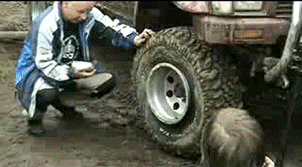








Gary








Gary




www.thehappypermaculturalist.wordpress.com





QuickBooks set up and Bookkeeping for Small Businesses and Farms - jocelyncampbell.com
 1
1








Suzy_Bean wrote:
Hey folks! Here is a link to Paul's podcast 025, which covers using Northwestern Farm Terriers as livestock guardian dogs. http://www.richsoil.com/permaculture/










http://wildernessreturn.wordpress.com/
my wilderness return story and adveture








www.thehappypermaculturalist.wordpress.com




I live in Bizzaro World.




paul wheaton wrote:My reading suggests that having just one dog might be 98% effective. But that last 1.7% would probably be well worth it.
My project thread
Agriculture collects solar energy two-dimensionally; but silviculture collects it three dimensionally.




My project thread
Agriculture collects solar energy two-dimensionally; but silviculture collects it three dimensionally.
 1
1








Susan Monroe wrote:It is bait in a sense. For instance, if you have chickens and raccoons: put the proper amount of that Lithium chloride in a dead chicken and let the raccoon eat it. The Lithium chloride is not detectable, and it makes the raccoon sick and nauseous. It happens fast enough so the raccoon makes the connection between his sickness and the chicken, so it doesn't want to eat chickens again.
Sue
 2
2
















 1
1




Leah Sattler wrote:
is there any kind of lgd that is known for being quiet?
Tamarack Lamb & Wool
Ile de France x Dorset sheep




http://kitchengardens.net
http://agrari.us
http://claddaghfarms.com





My books, movies, videos, podcasts, events ... the big collection of paul wheaton stuff!





How permies.com works
What is a Mother Tree ?








bob day wrote:i don't know if that puma is dead, it's head and neck seem to be straining up toward the mule like it's still trying to get a piece of him
The lion was dead before the mule Berry took and shook the lion. A lion is a powerful and lethal predator and can easily kill a mule — however a mule can be quite an adversary.
My project thread
Agriculture collects solar energy two-dimensionally; but silviculture collects it three dimensionally.








Cj Verde wrote:
bob day wrote:i don't know if that puma is dead, it's head and neck seem to be straining up toward the mule like it's still trying to get a piece of him
I highly doubt it's a puma. Donkeys are only good at protection if they prey is a member of the canine family. Useless against felines.




Meryt Helmer wrote:
That is a feline for sure though in the photo. Canines don't look like that.
My project thread
Agriculture collects solar energy two-dimensionally; but silviculture collects it three dimensionally.
 2
2




 1
1




paul wheaton wrote:I think this picture speaks to what a donkey can do. I'm going to have to change my stance on donkeys.
My project thread
Agriculture collects solar energy two-dimensionally; but silviculture collects it three dimensionally.




My Signature for the last few years was "just spinning wheels," but after our PDC at Pauls Place this summer I feel like we are finally catching traction. Hope to be threading some more. got a roof on our house, swales dug, and finally starting to work on our plan in more details.
 1
1




"You must be the change you want to see in the world." "First they ignore you, then they laugh at you, then they fight you, then you win." --Mahatma Gandhi
"Preach the Gospel always, and if necessary, use words." --Francis of Assisi.
"Family farms work when the whole family works the farm." -- Adam Klaus
 1
1




 1
1








M Johnston wrote:Hi all!
Had an Arabian stallion save our three girls from a black bear attack. Nice horse--gets a lot of treats! Several Arabians and one quarter horse in the pasture will actively chase predators. However, due to growing predator pressure in our area, we also found a LGD that is not very common....but very cool! A Caucasian Shepard, and there are very few of them in the US, but her personality is awesome, and her level of watchfulness is pretty neat. We were trying to find a mind like a Doberman Pinscher--very alert, very intelligent and discerning, while still loving and interactive--um....with um....actual FUR (because a guard dog in a coat and mittens just doesn't look as tough.). Also, one of the few dog breeds that will successfully take on a wolf. However, it is a good idea to have more than one...probably of almost any type of LGD. Also, we have an English Shepard and her two Australian Shepard cross daughters and they are very alert. The English has taken after at least one coyote. Best wishes!
This is my signature.
There are many like it, but this one is mine.




Hearts in Hand Horsemanship LLC, Faith, Family, Service... Wwoof-usa and Permies Host to those who wish to learn.




“The most important decision we make is whether we believe we live in a friendly or hostile universe.”― Albert Einstein




R Fracassa wrote:One dog has never been enough for us. When we have two dogs, it's been fine. Finding a good dog has been the hardest part. Our 6-year-old apartment-raised Pyrenees was the best with chickens.

|
A mime should never say "Look! I'm in a box!" Now watch this tiny ad:
permaculture and gardener gifts (stocking stuffers?)
https://permies.com/wiki/permaculture-gifts-stocking-stuffers
|





